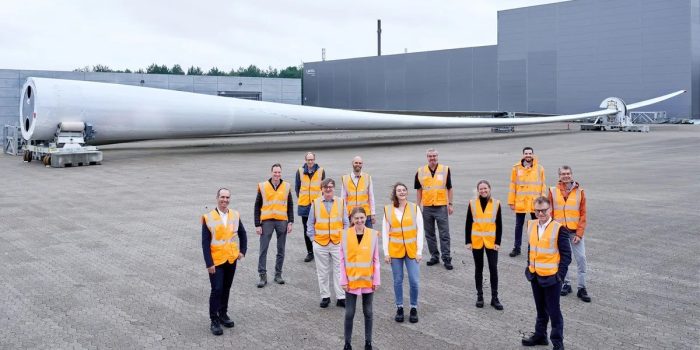The ZEBRA (Zero wastE Blade ReseArch) consortium achieved a major milestone in advancing the circular economy within the wind industry with the production of its second recyclable thermoplastic wind turbine blade.
The announcement, made on December 15, highlighted the completion of full-scale validation testing for the first blade and the groundbreaking use of recycled Elium resin in the shear web of the second blade, a component crucial to the blade’s structure.
The blade, an impressive 77 meters in length, was manufactured at LM Wind Power’s blade plant in Castellón, Spain, marking a significant step toward realizing environmentally friendly blade designs in the wind energy sector.

The use of recycled Elium resin in the shear web of the ZEBRA blade is a pioneering achievement, making it the first of its kind in the world. This breakthrough not only showcases the technical expertise of the ZEBRA consortium but also emphasizes the potential of Elium resin technology in promoting circularity in the wind energy industry. The success of the second blade builds on the insights gained from the creation of the first blade and paves the way for further exploration of Elium resin in carbon blades.
John Korsgaard, Senior Director at LM Wind Power, emphasized the importance of the second ZEBRA blade, noting that it marks a key milestone for the project and sets a new standard for sustainability in the wind energy sector. He also highlighted the significance of collaboration in technology development, acknowledging the efforts of partners in demonstrating recycling technologies for Elium-based composites.
“This blade marks a key milestone for the ZEBRA project and highlights the significance of plant collaboration in new technology development, in addition to supporting sustainability objects for our company and our customers,” he added while complimenting the efforts of his partners to demonstrate recycling technologies for Elium based composites using glass and carbon fibers.

Guillaume SANA, project leader at the IRT Jules Verne, expressed enthusiasm for the project’s progress, emphasizing the major achievement for both the consortium and the wind energy industry. Looking ahead, SANA outlined key milestones for 2024, including a complete life cycle analysis based on ZEBRA project blades, a focus on recycling activities, and the completion of validation testing on the second blade featuring the new Carbon-Elium resin spar cap.
The ZEBRA project, initiated in September 2020 and led by the French research center IRT Jules Verne, involves collaboration with leading industrial companies such as Arkema, CANOE, ENGIE, LM Wind Power, Owens Corning, and SUEZ. Launched to demonstrate the technical, economic, and environmental relevance of thermoplastic wind turbine blades on a full scale, the project adopts an eco-design approach to facilitate recycling.
Since the manufacturing of the first recyclable ZEBRA blade in March 2022, the consortium has been actively engaged in intensive development and testing phases, with a focus on realizing a Carbon-Elium resin spar design. The project underscores the commitment to international collaboration and sustainability in advancing wind energy technologies.


